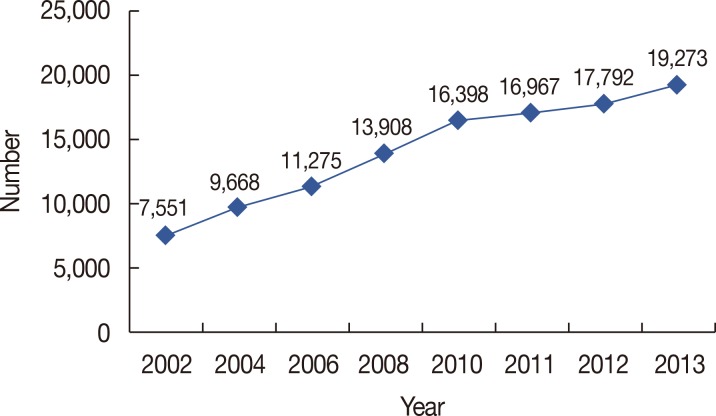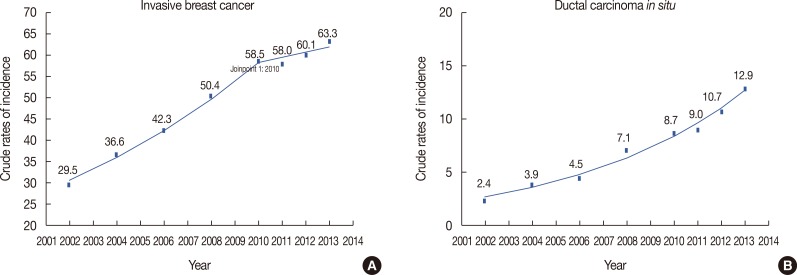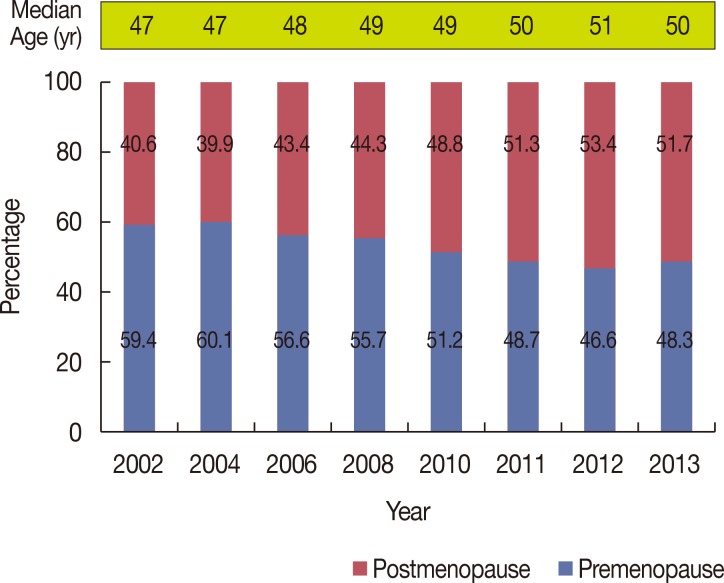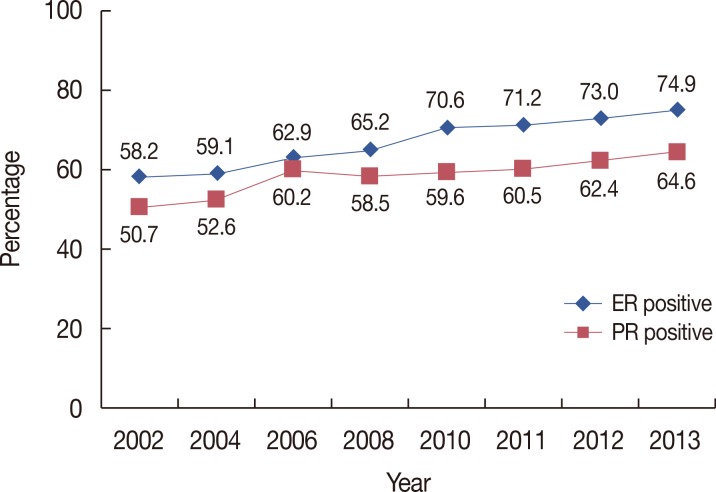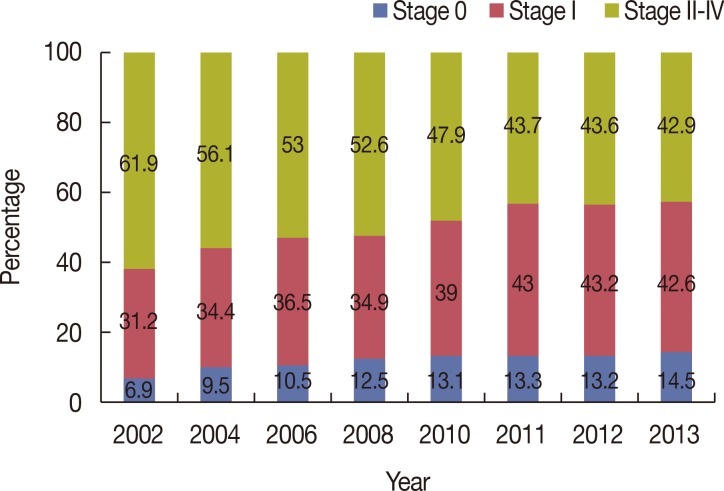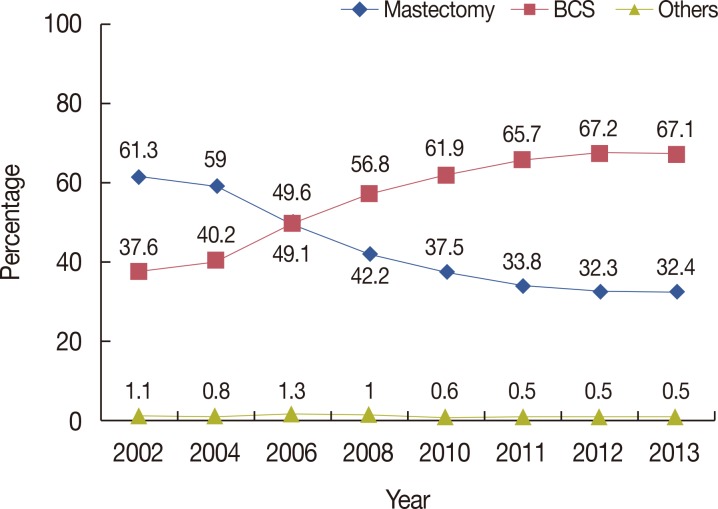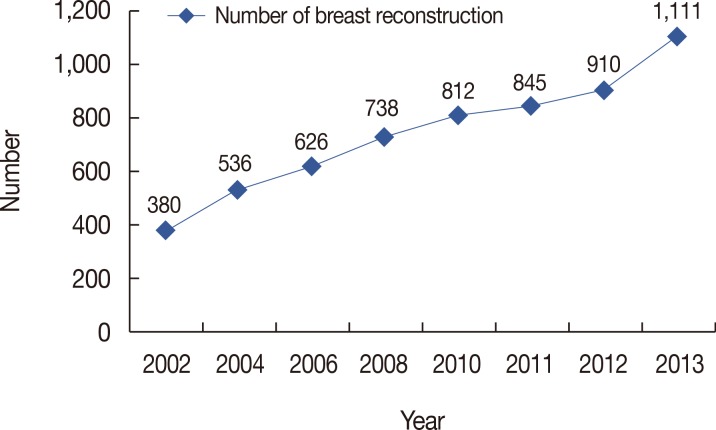Abstract
The Korean Breast Cancer Society (KBCS) has reported a nationwide breast cancer data since 1996. We present a comprehensive report on the facts and trends of breast cancer in Korea in 2013. Data on the newly diagnosed patients in the year 2013 were collected from 99 hospitals by using nationwide questionnaire survey. Clinical characteristics such as stage of cancer, histologic types, biological markers, and surgical management were obtained from the online registry database. A total of 19,316 patients were newly diagnosed with breast cancer in 2013. The crude incidence rate of female breast cancer including carcinoma in situ was 76.2 cases per 100,000 women. The median age at diagnosis was 50 years, and the proportions of postmenopausal women with breast cancer accounted for more than half of total patients. The proportion of early breast cancer increased consistently, and the pathologic features have changed accordingly. Breast-conserving surgery was performed in more cases than total mastectomy in the year. The total number of breast reconstruction surgeries markedly increased approaching 3-fold in last 11 years. According to annual percentile change of invasive cancer incidence, the incidence increased rapidly until 2010. And thereafter the increase of it became steadier. For ductal carcinoma in situ, the incidence consistently increased during the same period without any joinpoint. Analysis of nationwide registry data will contribute to defining of the trends and characteristics of breast cancer in Korea.
Keywords: Breast neoplasms, Korea, Online systems, Registries
INTRODUCTION
Cancer is the highest leading cause of death in Korea since 2001 [1,2,3]. It has become a major burdensome disease to individuals and society [4]. In Korea, breast cancer is the second most common female cancer since 2004. The incidence of Korean breast cancer increased steeply over the last decade. In 2012, 17,792 new breast cancer patients were reported and the age-standardized in incidence rate of female breast cancer was 52.1 per 100,000 [1,2,3].
The Korean Breast Cancer Society (KBCS) made a nationwide, hospital-based, breast cancer registry in 1996, and the details of its history, objectives, and activities have been well descripted [5,6,7,8,9,10,11,12]. Since the development of an online registration program in 2001, the database has been actively used for various studies on breast cancer in Korea.
The aim of this study was to report and analyze the basic facts about breast cancer in Korea in 2013, including incidence, clinical characteristics, the management of breast cancer, and their trends from 2002 to 2013.
Data sources
Data were collected on women in Korea who were newly diagnosed patients with primary breast cancer between January 1, 2013 and December 31, 2013. A nationwide questionnaire survey was used for the total number of patients newly diagnosed with breast cancer (including ductal carcinoma in situ [DCIS] and invasive breast cancer), and the age of these patients. A total of 99 hospitals answered this questionnaire (See the Supplement). Additional data such as cancer stage, type of surgery, pathological information (biological markers and histological types) were obtained from the KBCS online breast cancer registry (http://registry.kbcs.or.kr/ecrf/login.php).
Statistical analysis
Crude rates (CRs) of cancer incidence were calculated using data of the nationwide questionnaire survey. Annual percent change (APC) was calculated for characterization of the trends in cancer rates over time. With this method, the cancer rates are estimated to change at a constant percentage of the rate of the previous year. And average annual percent change (AAPC) was calculated, also. AAPC is a summary measure of the trend over a pre-specified fixed interval [13]. AAPC is applied to use a single number to describe the average APCs over a period of many years. We used a joinpoint regression model [14] to analyze the years when there were significant changes in the CRs of incidence. We used the Joinpoint Regression Program (version 4.2.0.2) developed by the U.S. National Cancer Institute. This program is a Windows-based statistical software that analyzes joinpoint models [13]. Joinpoint regression method identifies changes in data trends by straight light segments joined at "joinpoint." At "Joinpoint," crude incidence rate trend changes its slope statistically significantly [15]. The APC and the corresponding 95% confidence interval (CI) were calculated for each line segment and the AAPC of total period (2002-2013) was estimated.
We also analyzed the trends in the proportion of stages, biological markers, median age by linear regression analysis and a p-value <0.05 was regarded as statistically significant (95% level of confidence). To determine the reliability of the survey data, we examined the correlation coefficients and compared APC between the crude incidence rate trends in Korean Statistical Information Service (KOSIS) and our survey data during the same period, 2002 to 2013. The correlation coefficients were 0.99 (p<0.001), and there was no significant difference between the groups.
BASIC FINDINGS OF KOREAN BREAST CANCER IN 2013
Total number of newly diagnosed breast cancer patients
A total of 19,316 patients were newly diagnosed with breast cancer in 2013. It contained 16,012 patients of invasive breast cancer and 3,264 patients of DCIS. Male breast cancer including DCIS was 43 cases, 0.2% of the total number. The crude incidence rate of female breast cancer including carcinoma in situ was 76.2 per 100,000 women per year. Sixteen thousand six hunderd seven cases (86%) are diagnosed at 68 university hospitals, 2,576 cases (13.3%) at 27 general hospitals. And, 133 cases (0.7%) are diagnosed at four private clinics.
Age distribution
Analyses of the survey data and registry data showed equivalent results in the age distribution of newly diagnosed patients (Table 1). The median age at diagnosis was 50 years, the youngest patient was 15 years old, and the oldest 93 years old. The age group with the highest number of patients was the 40–49 year olds (6,559 cases, 34.1%), followed by the 50–59 year olds (5,767 cases, 30%).
Table 1. Age distribution of newly diagnosed breast cancer patients in Korea, 2013.
| Year 2013 | Survey data No. of patients (%) |
KBCS registry data No. of patients (%) |
|---|---|---|
| Age (yr) | ||
| < 20 | 4 (0.02) | 4 (0.03) |
| 20–29 | 180 (0.9) | 135 (1.1) |
| 30–39 | 1,822 (9.5) | 1,288 (10.3) |
| 40–49 | 6,559 (34.1) | 4,620 (36.9) |
| 50–59 | 5,767 (30.0) | 3,889 (31.1) |
| 60–69 | 2,554 (13.3) | 1,713 (13.7) |
| 70–79 | 1,148 (6.0) | 774 (6.2) |
| > 80 | 150 (0.8) | 99 (0.7) |
| Unknown | 1,046 (5.4) | 0 |
| Total | 19,230 (100.0) | 12,522 (100.0) |
KBCS=Korean Breast Cancer Society.
Surgery and staging
The information of surgical methods was obtained from KBCS online registry data. Among 12,522 patients, breast-conserving surgery (BCS) was most frequently performed (8,366 cases, 66.8%), followed by total mastectomy (4,036, 32.2%) (Table 2). Among online registry data, stage I was the most frequent diagnosis (5,152 cases, 41.1%). Stage II was the second frequent as 3,895 cases (31.1%) and stage 0 was 1,749 cases (14.0%), respectively (Table 3).
Table 2. Surgical management of newly diagnosed breast cancer patients, 2013 (KBCS registry data).
| Surgery | No. of patients (%) |
|---|---|
| Mastectomy | 4,036 (32.2) |
| BCS | 8,366 (66.8) |
| Others | 57 (0.5) |
| Unknown | 63 (0.5) |
| Total | 12,522 (100.0) |
KBCS=Korean Breast Cancer Society; BCS=breast-conserving surgery.
Table 3. Stage distribution of newly diagnosed breast cancer patients, 2013 (KBCS registry data).
| Stage | No. of patients (%) |
|---|---|
| 0 | 1,749 (14.0) |
| 1 | 5,152 (41.1) |
| 2 | 3,895 (31.1) |
| 3 | 1,121 (9.0) |
| 4 | 175 (1.4) |
| Unknown | 430 (3.4) |
| Total | 12,522 (100.0) |
KBCS=Korean Breast Cancer Society.
Pathology and biological markers
Among the 10,516 patients whose pathologic results were reported on online registry, invasive ductal carcinoma was the most common histologic type (8,375 cases, 79.6%), followed by DCIS (1,417 cases, 13.5%) and invasive lobular carcinoma (432 cases, 4.1%) (Table 4).
Table 4. Histological types, 2013 (KBCS registry data).
| Histologic type | No. of patients (%) |
|---|---|
| Ductal carcinoma in situ | 1,417 (13.5) |
| Invasive ductal carcinoma | 8,375 (79.6) |
| Lobular carcinoma in situ | 64 (0.6) |
| Invasive lobular carcinoma | 432 (4.1) |
| Paget's disease (pure form) | 7 (0.07) |
| Malignant phyllodes tumor | 37 (0.34) |
| Lymphoma | 1 (0.01) |
| Sarcoma | 8 (0.08) |
| Others | 175 (1.7) |
| Total | 10,516 (100.0) |
KBCS=Korean Breast Cancer Society.
The proportions of patients with tumors positive for estrogen receptor (ER) and progesterone receptor (PR) expression were 74.9% and 64.6%. When c-erbB-2 expression was identified, 32.7% of all patients were found to have tumors negative for immunohistochemical (IHC) staining. 25.4% had 1+ rating in IHC staining, 19.9% had 2+ rating, and 18.2% had 3+ rating (Table 5).
Table 5. Biological markers, 2013 (KBCS registry data).
| Biologic marker | No. of patients (%) |
|---|---|
| ER | |
| Negative | 2,557 (24.5) |
| Positive | 7,828 (74.9) |
| Unknown | 64 (0.6) |
| Total | 10,449 (100.0) |
| PR | |
| Negative | 3,624 (34.8) |
| Positive | 6,739 (64.6) |
| Unknown | 65 (0.6) |
| Total | 10,428 (100.0) |
| c-erbB-2 | |
| Negative | 3,351 (32.7) |
| Weak (1+) | 2,602 (25.4) |
| Intermediate (2+) | 2,046 (19.9) |
| Strong (3+) | 1,864 (18.2) |
| Unknown | 394 (3.8) |
| Total | 10,257 (100.0) |
KBCS=Korean Breast Cancer Society; ER=estrogen receptor; PR=progesterone receptor.
CHANGING PATTERNS OF BREAST CANCER IN KOREA
Incidence
The number of newly diagnosed breast cancer patients in Korea has increased continuously over the last decade. In 2013, the number of newly diagnosed female breast cancers were 19,273. Compared with 7,551 patients in 2002, it was 2.6 times increased (155.2% increase; R2=0.995, p<0.001) (Figure 1) [8,10,11,12]. The crude incidence rate of female breast cancer in Korea in 2013, including cases of DCIS was calculated to be 76.2 cases per 100,000 women. According to individual cancer invasiveness, the crude incidence rate of invasive carcinoma was 63.3 cases per 100,000 women. The crude incidence rate of DCIS was 12.9 cases per 100,000 women. The CRs of invasive cancer significantly increased from 2002 through 2013 with an AAPC of +6.7% (95% CI, 5.9%–7.5%, p<0.001), and the CRs of DCIS increased with an AAPC of +15.1% (95% CI, 11.4%–19.0%, p<0.001) (Table 6).
Figure 1. Number of newly diagnosed breast cancer patients from 2002 to 2013 in Korea (Korean Breast Cancer Society survey data).
Table 6. Trends in crude incidence rates for breast cancer according to joinpoint analysis (KBCS survey data, 2002–2013).
| AAPC 2002–2013 | Trend 1 | Trend 2 | |||||||
|---|---|---|---|---|---|---|---|---|---|
| Period | APC | 95% CI | Period | APC | 95% CI | ||||
| Lower | Higher | Lower | Higher | ||||||
| Invasive breast cancer | +6.7* | 2002–2010 | +8.5* | 7.3 | 9.8 | 2010–2013 | +2.0* | -1.7 | 6.0 |
| DCIS | +15.1* | 2002–2013 | +15.1* | 13.5 | 16.6 | - | - | - | - |
KBCS=Korean Breast Cancer Society; AAPC=average annual percent rate change, %; APC=annual percent rate change, %; CI=confident interval; DCIS=ductal carcinoma in situ.
*The annual percent rate change is significantly different from 0 (two-sided p<0.05).
Table 6 and Figure 2 showed the trends in breast cancer incidence in Korea according to invasiveness. For invasive cancer, there was 1 joinpoint at 2010. A continuous significant increase of the CRs was observed with an APC of +8.5% (95% CI, 7.3%-9.8%) until 2010, and thereafter the CRs increase had slowed with an APC of +2.0% (95% CI, -1.7%–6.0%). However, slowing of increase of the CRs from 2010 to 2013 was not statistically significant. The CRs of DCIS consistently increased without any joinpoint during observed period (2002–2013).
Figure 2. Trends in crude incidence rates of Korean female breast cancer from 2002 to 2013 (Korean Breast Cancer Society survey data). (A) Crude incidence rates of invasive breast cancer. (B) Crude incidence rates of ductal carcinoma in situ.
Median age at diagnosis
The median age at diagnosis was 50 years in 2013 similar to result of median age in 2012. The proportions of postmenopausal women with breast cancer accounted for more than half of total cases since 2011 (Figure 3) [11,12].
Figure 3. Trends in the median age at breast cancer diagnosis from 2002 to 2013 in Korea, and the ratio of postmenopausal to premenopausal women at diagnosis.
Biologic markers and stage distributions
Both the proportions of ER- and PR-positive breast cancer patients consistently increase since 2002. The proportion of ER-positive breast cancer patients increased from 58.2% in 2002 to 74.9% in 2013 (28.6% increase; R2=0.990, p< 0.001), and that of PR-positive breast cancer patients increased from 50.7% in 2002 to 64.6% in 2013 (27.4% increase; R2=0.926, p<0.001) (Figure 4). With regard to stage distribution, the proportion of patients with stage 0 and stage I breast cancer has steadily increased since 2002 and accounted for more than half of total breast cancer patients since 2010. Especially, the proportion of stage 0 cancer patients increased from 6.9% to 14.5% (110.1% increase; R2=0.968, p<0.001). On the contrary, the proportion of patients with stage II to IV cancers decreased from 61.9% to 42.9% (30.7% decrease; R2=0.982, p<0.001) (Figure 5).
Figure 4. Changing trends in the hormone receptor-positive breast cancer.
ER=estrogen receptor; PR=progesterone receptor.
Figure 5. Changes in breast cancer incidence according to stage.
Surgical patterns
Change of surgical patterns of breast cancer was observed during period from 2002 to 2013. The proportion of BCS and that of total mastectomy had reversed since 2006. The proportion of patients who was performed BCS increased from 37.6% in 2002 to 67.1% in 2013 (78.5% rise; R2=0.989, p<0.001). Meanwhile, the proportion of patients who underwent total mastectomy decreased from 61.3% in 2002 to 32.4% in 2013 (47.1% decrease; R2=0.988, p<0.001) (Figure 6).
Figure 6. Changes in the surgical management of breast cancer. BCS=breast-conserving surgery.
The number of breast reconstructions performed after total mastectomy markedly increases from 380 cases in 2002 to 1,111 cases in 2013 (192.4% increase; R2=0.976, p<0.001) (Figure 7).
Figure 7. Changing trends in breast reconstruction in patients with breast cancer surgery.
DISCUSSION
Breast cancer is the second most common cancer worldwide, and the most frequent cause of cancer death in women in the world. Age-standardized incidence of Korean breast cancer was 52.1 cases per 100,000 women in 2012. Korea became one of the countries in the world with the fastest increasing of breast cancer incidence [16].
We reported the basic facts of the Korean breast cancer and analyzed the trends in cancer incidence between 2002 and 2013 using KBCS registry data and nationwide survey data. KBCS registry system was initiated in 1996 and online registration program was established in 2001. This nationwide registry data were used as the foundation of our annual report as well as various research studies. Compared with data from KOSIS (17,231 women patients), our collected survey data represented 92.9% of women patients with invasive breast cancer.
The clinical facts derived from these data were as follows. The first was that the number of newly diagnosed breast cancer patients was still on the increase, it was increasing at close to about 20,000 patients per year. Secondly, the median age of patients at the time of diagnosis was 50 years in 2013. This was similar to results of 2012 [12], and the proportion of postmenopausal women had remained around half of total patients. Thirdly, the proportion of patients who underwent BCS was higher than that of patients who underwent total mastectomy. However, the changes in trend of surgical methods was not significant in the year of 2013. The proportion of stage 0 and stage I was constantly increasing, particularly. The proportion of stage 0 breast cancer highly increased. The proportion of classification according to histologic type was not changed. And the proportion of patients who had tumor with +3 expression of c-erbB-2 was not changed, also. Meanwhile, the proportion of ER positive breast cancer patients steadily increased. Finally, the number of patients who underwent breast reconstruction rose rapidly over recent years.
Korea is categorized to high-income countries, which have the highest incidence rate of cancer worldwide. Korea was rated to have the highest incidence rate of breast cancer in Asia (52.1 cases per 100,000 women) in 2012 [16].
In Korea, the incidence rate of breast cancer has increased steeply until the recent years. As we analyzed the trends in cancer incidence of female breast cancer in Korea between 2002 and 2013, we could find the fine change of incidence. Female breast cancer showed the plateau of CRs in the recent years. The APC of CRs of invasive cancer dropped in the last quarter period (from 8.5%, 2002-2010; to 2.0%, 2010–2013). Meanwhile, the APC of CRs of DCIS showed no sign of standstill or decline. As we analyzed the trend with 0 to 2 joinpoints for DCIS, the slope of each line segment was changed in 2008. And, APC of CRs of it was significantly changed from 17.4% to 12.5%. But, it was not the best-fitting model for DCIS. The Joinpoint Regression Program showed that CRs of DCIS was still increased without any joinpoint. In Japanese studies for the trends in cancer incidence with joinpoint regression analysis between 1985 and 2013, APC of female breast cancer was 3.9% and age-standardized rates of incidence was continuously increased during the observation periods. Also, APC of female breast cancer incidence including carcinoma in situ was increased much more after 2002 (3.8% in 1985–2002, 95% CI, 3.4%–4.2%; 5.9% in 2002–2010, 95% CI, 5.0%–6.8%) [17,18]. These changes will be followed to confirm whether it is real change or not.
The median age of patients at the diagnosis of breast cancer was 50 years in 2013, with the proportion of postmenopausal women exceeding half the total number of cases. It was similar with the median age in 2012. Anyway, it was still lower by 10 years than that of the United States, which was 61 years from 2006 to 2010 [19]. The trend of median age at diagnosis will be followed more.
The surprising change of basic facts of female breast cancer in 2013 was the consistency of the proportion of BCS, which increased until 2012. The proportion of BCS was 67.2%, and the proportion of mastectomy was 32.3% in 2012. In 2013, the proportion of BCS was decreased to 67.1% and the proportion of mastectomy was just a little increased to 32.4%. This reversal of surgery patterns was found in the operation of the United States, also. A cohort study of the Surveillance, Epidemiology, and End Results (SEER) had higher mastectomy rates with a similar downward trend for 40% in 2000 to 36% between 2005 and 2006, but a subsequent increase to 38% in 2008 [20]. In early breast cancers, the proportion of BCS-eligible patients who underwent mastectomy increased from 34.3% in 1998 to 37.8% in 2011 with the most striking increase in mastectomy rates occurring after 2006 [21]. Reasons for the change of surgical patterns are not clear. But, the wider use of breast magnetic resonance imaging, the genetic testing, sharing the decision making by patients, trends in surgical choice have been suggested to contribute to this change of surgical patterns in the report [22,23,24]. The number of breast reconstruction after mastectomy increased rapidly in Korea over the last 11 years (192.4% increase; R2=0.0976, p<0.001), accordingly. Jagsi et al. [25] reported the increased trends of reconstruction from 46% in 1998 to 63% in 2007. Further investigation about the trend of our surgical patterns is warranted.
The following limitations should be considered. First, because our data was based on a nationwide survey, there were differences between our data and that of the National Cancer Registry (NCR). Our data represented 92.9% (16,012 cases) of women patients with invasive breast cancer (17,231 cases) of the NCR. We believe that this data is sufficient to support our results, considering SEER data in the United States. Second, our results of incidence was not age-standardized. Survey data should be complemented by subdivision of age groups.
CONCLUSION
The basic facts of Korean breast cancer have been changed in the years up to 2013. There are several changes of clinical characteristics of breast cancer in Korea, steadily and continuously. The proportion of early breast cancer and the proportion of hormone receptor-positive breast cancer increased consistently. BCS was performed in more cases than total mastectomy in the year. The total number of breast reconstruction surgeries markedly increased approaching 3-fold in last 11 years. According to APC of invasive cancer incidence, the incidence increased rapidly until 2010 and thereafter the increase of it became steadier. A continuous study using the nationwide registry data will provide more definite informations that can be used to understand the trends and features of breast cancer in Korea.
ACKNOWLEDGMENTS
We thank all members of the Korean Breast Cancer Society (KBCS) who participated in this nationwide survey and KBCS online registry.
Footnotes
CONFLICT OF INTEREST: The authors declare that they have no competing interests.
Supplementary Material
References
- 1.Cancer statistics. National Cancer Information Center, Ministry of Health and Welfare. [Accessed January 15th, 2016]. http://www.cancer.go.kr.
- 2.Statistics Korea 2015. Korean Statistical Information Service. [Accessed January 18th, 2016]. http://kosis.kr.
- 3.Jung KW, Won YJ, Kong HJ, Oh CM, Cho H, Lee DH, et al. Cancer statistics in Korea: incidence, mortality, survival, and prevalence in 2012. Cancer Res Treat. 2015;47:127–141. doi: 10.4143/crt.2015.060. [DOI] [PMC free article] [PubMed] [Google Scholar]
- 4.Yoon SJ, Bae SC, Lee SI, Chang H, Jo HS, Sung JH, et al. Measuring the burden of disease in Korea. J Korean Med Sci. 2007;22:518–523. doi: 10.3346/jkms.2007.22.3.518. [DOI] [PMC free article] [PubMed] [Google Scholar]
- 5.Korean Breast Cancer Society. Korean breast cancer data of 1996. J Korean Surg Soc. 1998;55:621–635. [Google Scholar]
- 6.Korean Breast Cancer Society. Korean breast cancer data of 1997. J Korean Cancer Assoc. 1999;31:1202–1209. [Google Scholar]
- 7.Ahn SH, Yoo KY Korean Breast Cancer Society. Chronological changes of clinical characteristics in 31,115 new breast cancer patients among Koreans during 1996-2004. Breast Cancer Res Treat. 2006;99:209–214. doi: 10.1007/s10549-006-9188-x. [DOI] [PubMed] [Google Scholar]
- 8.Ko BS, Noh WC, Kang SS, Park BW, Kang EY, Paik NS, et al. Changing patterns in the clinical characteristics of Korean breast cancer from 1996-2010 using an online nationwide breast cancer database. J Breast Cancer. 2012;15:393–400. doi: 10.4048/jbc.2012.15.4.393. [DOI] [PMC free article] [PubMed] [Google Scholar]
- 9.Ko SS Korean Breast Cancer Society. Chronological changing patterns of clinical characteristics of Korean breast cancer patients during 10 years (1996-2006) using nationwide breast cancer registration on-line program: biannual update. J Surg Oncol. 2008;98:318–323. doi: 10.1002/jso.21110. [DOI] [PubMed] [Google Scholar]
- 10.Jung YS, Na KY, Kim KS, Ahn SH, Lee SJ, Park HK, et al. Nation-wide Korean breast cancer data from 2008 using the breast cancer registration program. J Breast Cancer. 2011;14:229–236. doi: 10.4048/jbc.2011.14.3.229. [DOI] [PMC free article] [PubMed] [Google Scholar]
- 11.Kim Z, Min SY, Yoon CS, Lee HJ, Lee JS, Youn HJ, et al. The basic facts of Korean breast cancer in 2011: results of a nationwide survey and breast cancer registry database. J Breast Cancer. 2014;17:99–106. doi: 10.4048/jbc.2014.17.2.99. [DOI] [PMC free article] [PubMed] [Google Scholar]
- 12.Kim Z, Min SY, Yoon CS, Jung KW, Ko BS, Kang E, et al. The basic facts of Korean breast cancer in 2012: results from a Nationwide Survey and Breast Cancer Registry Database. J Breast Cancer. 2015;18:103–111. doi: 10.4048/jbc.2015.18.2.103. [DOI] [PMC free article] [PubMed] [Google Scholar]
- 13.National Cancer Institute, Surveillance, Epidemiology, and End Results Program. National Cancer Institute Division of Cancer Control &Population Sciences. [Accessed January 31st, 2016]. http://surveillance.cancer.gov/joinpoint/webhelp/Executing_the_Joinpoint_Parameters/Statistical_Notes/Statistics_Related_to_the_k-joinpoint_Model/Average_Annual_Percent_Change.htm. [Google Scholar]
- 14.Kim HJ, Fay MP, Feuer EJ, Midthune DN. Permutation tests for joinpoint regression with applications to cancer rates. Stat Med. 2000;19:335–351. doi: 10.1002/(sici)1097-0258(20000215)19:3<335::aid-sim336>3.0.co;2-z. [DOI] [PubMed] [Google Scholar]
- 15.Lim D, Ha M, Song I. Trends in major cancer mortality in Korea, 1983-2012, with a joinpoint analysis. Cancer Epidemiol. 2015;39:939–946. doi: 10.1016/j.canep.2015.10.023. [DOI] [PubMed] [Google Scholar]
- 16.Ferlay J, Soerjomataram I, Ervik M, Dikshit R, Eser S, Mathers C, et al. GLOBOCAN 2012 v1.0, Cancer Incidence and Mortality Worldwide: IARC CancerBase No. 11. International Agency for Research on Cancer; [Accessed January 24th, 2016]. http://globocan.iarc.fr. [Google Scholar]
- 17.Katanoda K, Matsuda T, Matsuda A, Shibata A, Nishino Y, Fujita M, et al. An updated report of the trends in cancer incidence and mortality in Japan. Jpn J Clin Oncol. 2013;43:492–507. doi: 10.1093/jjco/hyt038. [DOI] [PubMed] [Google Scholar]
- 18.Katanoda K, Hori M, Matsuda T, Shibata A, Nishino Y, Hattori M, et al. An updated report on the trends in cancer incidence and mortality in Japan, 1958-2013. Jpn J Clin Oncol. 2015;45:390–401. doi: 10.1093/jjco/hyv002. [DOI] [PubMed] [Google Scholar]
- 19.Howlader N, Noone AM, Krapcho M, Garshell J, Neyman N, Altekruse SF, et al. SEER cancer statistics review, 1975-2010. National Cancer Institute; [Accessed February 2nd, 2016]. http://seer.cancer.gov/csr/1975_2010/ [Google Scholar]
- 20.Mahmood U, Hanlon AL, Koshy M, Buras R, Chumsri S, Tkaczuk KH, et al. Increasing national mastectomy rates for the treatment of early stage breast cancer. Ann Surg Oncol. 2013;20:1436–1443. doi: 10.1245/s10434-012-2732-5. [DOI] [PubMed] [Google Scholar]
- 21.Kummerow KL, Du L, Penson DF, Shyr Y, Hooks MA. Nationwide trends in mastectomy for early-stage breast cancer. JAMA Surg. 2015;150:9–16. doi: 10.1001/jamasurg.2014.2895. [DOI] [PubMed] [Google Scholar]
- 22.Evans DG, Barwell J, Eccles DM, Collins A, Izatt L, Jacobs C, et al. The Angelina Jolie effect: how high celebrity profile can have a major impact on provision of cancer related services. Breast Cancer Res. 2014;16:442. doi: 10.1186/s13058-014-0442-6. [DOI] [PMC free article] [PubMed] [Google Scholar]
- 23.Balch CM, Jacobs LK. Mastectomies on the rise for breast cancer: "the tide is changing". Ann Surg Oncol. 2009;16:2669–2672. doi: 10.1245/s10434-009-0634-y. [DOI] [PMC free article] [PubMed] [Google Scholar]
- 24.Tracy MS, Rosenberg SM, Dominici L, Partridge AH. Contralateral prophylactic mastectomy in women with breast cancer: trends, predictors, and areas for future research. Breast Cancer Res Treat. 2013;140:447–452. doi: 10.1007/s10549-013-2643-6. [DOI] [PMC free article] [PubMed] [Google Scholar]
- 25.Jagsi R, Jiang J, Momoh AO, Alderman A, Giordano SH, Buchholz TA, et al. Trends and variation in use of breast reconstruction in patients with breast cancer undergoing mastectomy in the United States. J Clin Oncol. 2014;32:919–926. doi: 10.1200/JCO.2013.52.2284. [DOI] [PMC free article] [PubMed] [Google Scholar]
Associated Data
This section collects any data citations, data availability statements, or supplementary materials included in this article.



